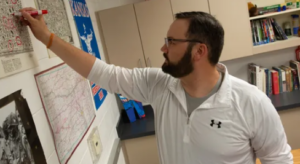ROSSVILLE — Kraig Westhoff is not on TikTok. No, sir — no chance you’d ever catch the Rossville eighth-grade social studies teacher on that social media platform.
That guy with the same name, face, classroom and even students? Couldn’t be Westhoff. The kids must be mistaken after they watch the TikTok videos and insist that some doppelganger is actually him.
No way that their small-town teacher is THAT Westhoff, the one who makes popular daily, bite-size videos about Kansas history and social studies. Even Westhoff’s own wife thinks it’s a bit far-fetched that anyone, let alone hundreds of thousands of TikTok users, would find her husband that interesting.
“They know I have (a TikTok), but I just keep denying it because it’s something I have to do to keep me entertained,” Westhoff admitted with a laugh. “Just the fact that these kids are watching it and getting on, they’re seeing me in a different light. They’re seeing that other people are also watching these videos, and they know I know my stuff.”
Like a lot of other people, Westhoff started using TikTok at the start of the pandemic. But it wasn’t until this January, when he was stuck home under COVID isolation for a few weeks, that he figured he might as well start actually posting to the platform, mostly as a way to keep busy, under the handle @westiesclass.
“I sat there and thought, ‘I could do this,'” the teacher said. “I could make these videos, and I could make them about what I was teaching.”
He found something special, though, especially when he started posting short videos teaching about the origin of Kansas county names.
And what started off as a small project to keep his students engaged quickly ballooned to a massive social media following, with thousands of followers from all across Kansas and across state lines.
When Westhoff began his TikTok videos, he reflected back on what made him want to be a history teacher in the first place. In college, he’d started off as an athletic training major before realizing he hated the topic.
“So I made a list of things I was good at,” he said. “At the top of that list was history, and talking about history.”
When he started the video series in January, the concepts were pretty basic, going over items like the three branches of government and each of the amendments in the Bill of Rights. Westhoff is also Rossville Jr./Sr. High School’s video production teacher, so a lot of those skills came in handy.
His first “hit,” though, was when he responded to a popular video that argued “Kansas” should be be pronounced like it is at the end of “Arkansas.”
In that video, Westhoff passionately delved into the Indigenous origins of the state’s name, with a short montage of Kansas’ “Carry on My Wayward Son,” John Brown and Dwight D. Eisenhower kicking off the video diatribe.
“THIS SLANDER WILL NOT STAND,” Westhoff wrote in that video’s description.
Lately, his most popular topic has been his series on the origin of each Kansas county’s name. Using a big county-by-county map of the state, Westhoff started off with Sumner County and is working his way through all 105.
Those videos exploded in popularity when they began showing up on user’s “For You” pages, and thousands of people regularly watch Westhoff’s near-daily videos.
His video on the origin of Johnson County’s name particularly resounded with viewers when they learned that namesake Thomas Johnson was a pro-slavery missionary who began the Shawnee Methodist Mission to forcibly assimilate Shawnee children.
“That’s messed up on so many levels, but I’m going to share that with (my students),” he said. “If I’m not excited or interested in what I’m teaching the kids will never be.”
Westhoff doesn’t pretend to exhaustively know Kansas history off the top of his head. But by making the videos, he said he tries to show his students how they can also quickly research and find authoritative sources to double check any claims they might come across on social media.
“I get to show them all that,” Westhoff said. “Here’s how you do research, and here’s how you can respond to questions. Here’s how you can use social media in a responsible way to both promote yourself and help others learn.”
In the 10 years Westhoff has been a teacher, social media has come a long way in how it intersects with classroom learning. It used to be that teachers were somewhat expected to keep a Twitter page with classroom updates, but Westhoff said he was never much for tweeting.
It’s a tired refrain, but then COVID hit, and like any other teacher, he had to rethink how he could keep delivering his lessons while keeping students engaged and learning.
He’s borrowed heavily from Dave Burgess’ “Teach Like A Pirate” book guide for teachers, and he tries to find good “hooks” to pull students into his lessons and videos.
“It’s about hitting the kids where they’re at,” Westhoff said. “There’s so much stuff not just on TikTok but on Snapchat and Instagram where it’s, ‘We’re going to spout this conspiracy theory.’ This is where they’re getting their information, so I’m going to put out my own stuff and at least know they’re getting the best of what I can teach.”
Even adults and teachers from around the region have become regular followers, and after a particularly popular video, Westhoff said a man reached out to him wishing to donate materials and supplies to his classroom.
“The first thing I did was make an Amazon wish list and share that with my other teachers, who also put stuff on there,” he said. “Because if I’m doing this, I don’t know what I’m doing half the time, and if it’s going to benefit anyone, it should benefit all the people I work with because we’re a very close team.”
Ann Flach, a science teacher at the school, said Westhoff’s TikTok account has been a something special for the whole building.
“He’s been so humble about the whole thing,” Flach said. “He’s less in it for the attention and more for giving people the chance to learn, and that just speaks to who Kraig is as a person.”
Westhoff’s TikTok videos this semester were not required viewing for students, and they never will be. The teacher said he understands that some parents might not want their kids on that platform, and most of what he goes over is content they get in class anyway.
Through his videos and through his regular teaching, though, Westhoff said he hopes students learn they can find something that interests them and share that passion, whether it’s on social media or in life.
“You don’t have to follow trends,” he said. “You don’t have to do what everybody else is doing. You can go out there and be your authentic self and share what you’re interested in.”
As reported in the Topeka Capital Journal





